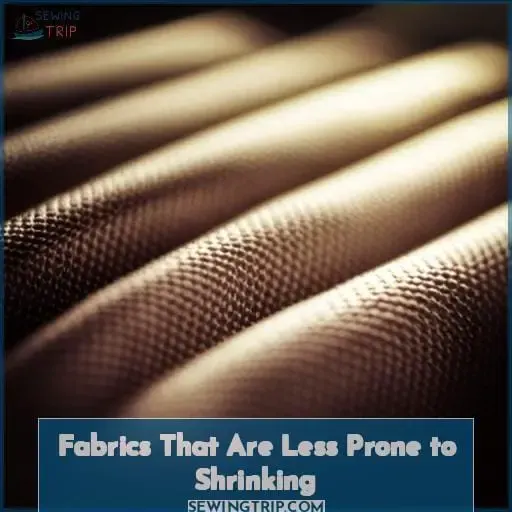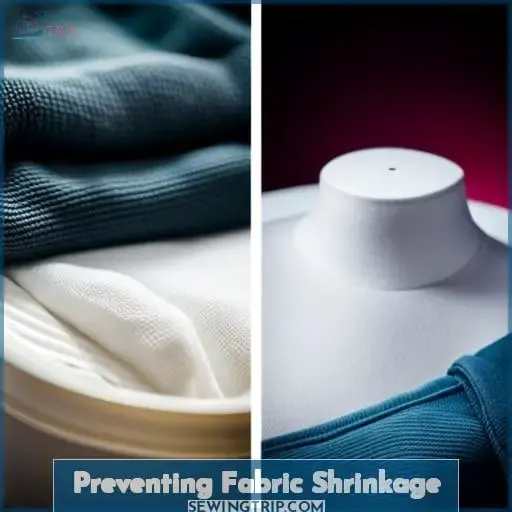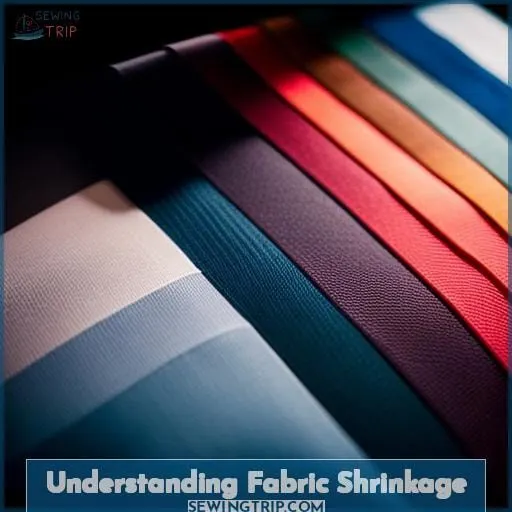This site is supported by our readers. We may earn a commission, at no cost to you, if you purchase through links.
 Are you wondering what fabrics are prone to shrinking? From cotton and wool to lace, leather, and suede, there are a variety of materials that can shrink when placed in the dryer.
Are you wondering what fabrics are prone to shrinking? From cotton and wool to lace, leather, and suede, there are a variety of materials that can shrink when placed in the dryer.
Read on for an overview of the effects heat has on fabric shrinkage as well as tips for unshrinking clothes. Plus, get an understanding of why different fibers react differently when exposed to heat.
With this knowledge at hand, it’s easier than ever before to take care of all your clothing needs with confidence!
Table Of Contents
- Key Takeaways
- Fabrics That Are Prone to Shrinking in the Dryer
- The Effects of Heat on Fabric Shrinkage
- Factors That Affect Fabric Shrinkage
- Fabrics That Are Less Prone to Shrinking
- The Process of Unshrinking Clothes
- The Relationship Between Fabric Type and Shrinkage
- The Role of Dryers in Fabric Shrinkage
- Preventing Fabric Shrinkage
- Can Shrunken Clothes Be Reversed?
- Understanding Fabric Shrinkage
- Conclusion
Key Takeaways
- Cotton and wool are fabrics that are prone to shrinking.
- Fabrics such as cotton blends, polyester, nylon, leather, and suede are less likely to shrink.
- Heat in dryers is one cause of fabric shrinkage.
- To prevent fabric from shrinking, it is recommended to wash in cold water, air dry, use low heat, and stretch the fabric if needed.
Fabrics That Are Prone to Shrinking in the Dryer
You know from experience that certain fabrics like cotton, wool, and lace will shrink if you accidentally toss them in the dryer. More delicate materials such as leather and suede should never see the inside of a dryer if you want to avoid disastrous shrinkage and damage.
The heat from the dryer can cause fibers in fabrics like cotton and wool to tighten up, resulting in shrinkage. Lace contains very delicate fibers that are prone to shrinking when exposed to heat. Materials like leather and suede are easily damaged when subjected to the tumbling and heat of a dryer – they will become misshapen and cracked.
To avoid accidental shrinkage or damage, carefully read clothing tags and follow care instructions.
Cotton
You’ll want to avoid drying your cotton tees and jeans in the dryer because they’ll shrink right up on you if you’re not careful! Cotton is a natural fiber that shrinks easily when exposed to heat. Air dry your cotton clothes after washing to keep them from getting too tight. Cotton shrinkage happens when the fibers relax and bunch together in the dryer.
Compared to synthetics like polyester, cotton is more prone to heat damage. Go easy on your cotton garments if you want them to keep their shape and size.
Wool
That itchy sweater Nana knitted will hug your frame like a clingy koala once it takes a spin in the dryer. To protect wool sweaters, skirts, and blankets from shrinkage, use cold water for washing. Lay them flat or hang to dry – never put wool in the dryer, as heat damages wool fibers.
To refresh wool garments without risking shrinkage, gently spot clean, use wool-safe detergent, and reshape while damp. With proper care, your treasured woolens will retain their beauty and fit for years.
Lace
Lace often shrinks when dried with heat, requiring gentle cycles or air drying to preserve its delicate structure. With an open weave and delicate fibers, lace can unravel when agitated and shrunk by hot tumble drying.
Lace garments need line drying or the most gentle machine cycle to avoid size loss and distortion. Unlike durable synthetics, lace requires special handling to maintain its beauty. Follow care instructions and air dry lace to retain its shape and intricate design intact for generations.
Leather
Leather never goes in the washer or dryer, hon, lest it ruin that beloved jacket.
- Use saddle soap to clean.
- Condition with leather oil.
- Let leather air dry.
- Store properly to avoid cracking.
The care required for leather helps preserve its beauty and durability for years to come. Leather responds best to special cleaners, conditioners, and gentle handling. With some basic maintenance, leather withstands the test of time.
Suede
You’d best keep your suede jacket out of the dryer unless you want it to shrivel up into a tiny, ruined mess.
| Dryer Action | Suede Reaction |
|---|---|
| Heat | Fibers shrink |
| Tumbling | Nap abrades |
| No Airflow | Moisture trapped |
| Lint Contact | Pilling occurs |
Handle suede with care – spot clean stains, air dry flat to preserve its soft, supple texture.
The Effects of Heat on Fabric Shrinkage
Heat is the main culprit that causes many fabrics to shrink, especially natural fibers like wool, cotton, and linen. Through processes like felting and fiber relaxation, heat from warm washes or dryers causes the fibers to tighten up and lose their original dimensions.
Shrinkage Caused by Felting
When wool gets jostled around too much in the dryer, its little fibers interlock so tight they can’t stretch back out again, and that’s how your sweater ends up shrunken like a wet woolly sheep fresh out of the wash.
Felting happens when heat, moisture, and agitation cause animal fibers like wool and cashmere to tangle and mat. It’s irreversible shrinkage, unlike relaxation shrinkage. Only protein-based natural fibers felt.
Synthetics like polyester won’t felt, though they can still shrink through other processes. Knits felt more easily than woven wools. Proper laundry care prevents felting shrinkage in delicate wools and cashmeres.
Shrinkage Caused by Relaxation
You’ll crumple that pure cotton shirt right up if you overdry it. Relaxation shrinkage sneaks up on natural fibers like cotton when they get too hot and dry in machines. Moisture keeps fabric relaxed before washing. Prevent relaxation shrinkage by skipping the heat of dryers for line drying.
Natural fibers need a cool, damp environment to stay relaxed and at full size after laundering.
Shrinkage Caused by Consolidation
You’ve surely noticed some shrinkage from the consolidation of fibers over repeated wash and dry cycles.
- Ease fabric tension during drying.
- Discard unused fabric scraps immediately.
- Select low heat settings to minimize friction.
Heat causes fibers to relax and compress together, reducing space between the threads and tightening the weave. Shrinkage over time can’t be completely prevented, but lowering dryer heat and promptly using cut yardage helps minimize it.
Shrinkage Caused by Contraction
Though heat can cause fabrics to consolidate and felt, it’s contraction that most noticeably shrinks your clothes. When heat hits cotton, wool, and other natural fabrics, the fibers contract and the overall dimensions shrink.
To prevent or reverse shrinkage, limit dryer time, gently stretch fabrics while wet, and hang clothes to air-dry. Taking precautions will help your favorite sweaters, jeans, and dresses maintain their original size and shape despite washing.
Use lower heat settings when drying clothes and avoid over-drying. Pulling and reshaping items while damp can also counteract shrinkage, as can line drying rather than machine drying whenever possible.
With some care, your garments can keep their fit and proportions even after many launderings.
Factors That Affect Fabric Shrinkage
You’ll want to pay close attention to a fabric’s type and composition when laundering, as natural fibers like cotton and wool are more prone to shrinkage than synthetic blends. The quality of the material and how it’s woven also makes a difference, since tighter weaves lacking stretch can lose more size when agitated and heated in the wash.
Fabric Type and Composition
Natural fibers like cotton and wool shrink more than synthetics, but you can reduce a cotton shirt’s shrinkage by 20% if you blend it with polyester.
- Synthetics like polyester and nylon shrink less than natural fibers.
- Blending cotton with polyester or spandex makes the fabric more resilient.
- Tighter weaves shrink less as the yarns can’t relax as much.
- Stretching fabrics while wet can help reverse shrinkage.
- Higher quality fabrics often shrink less due to pre-treatment.
- Delicate fabrics like cashmere and hemp require gentler washing to avoid excessive shrinkage.
The composition of a fabric significantly influences its shrinkage potential. Blending, weave tightness, stretching methods, and quality controls all play a role. With proper care, you can minimize shrinkage, even for more delicate natural fabrics.
Weave and Quality
The quality and tightness of a fabric’s weave impact how likely it will shrink when washed. Tightly woven fabrics shrink more as the threads have less room to move. Looser knits are more flexible during agitation.
High quality natural fibers may still shrink despite being loosely woven. Blends and synthetics vary. For maximum shrinkage prevention, opt for looser knits, low heat drying, and hang drying.
Stretching and Treatments
You’ve undertaken impressive work with that delicate cashmere sweater, yet despite gentle care it’s shrunk like pure wool in the dryer.
- Wet stretching while damp can help fibers relax.
- Fabric softeners make fibers slippery and prone to shrinking more.
- Look for preshrunk or shrink-resistant labels to help prevent surprise shrinkage.
Gently stretching while damp, skipping fabric softeners, and checking labels for shrink-resistance are simple but effective ways to help keep your sweaters fitting comfortably.
Fabrics That Are Less Prone to Shrinking
Many fabrics shrink to some degree in the washer or dryer, especially natural fibers like cotton and wool. However, certain fabrics like cotton blends, synthetics such as polyester and nylon, and leather and suede are far less prone to shrinkage when laundered properly.
Cotton Blends
You’d find cotton blends are more shrink-resistant than pure cotton. Blending cotton with polyester, nylon, or spandex reduces shrinkage while retaining cotton’s breathability. Handle blended fabrics gently, wash in cold water, and line dry to maximize durability.
Pair versatilely with jeans or dresses. Blends withstand frequent washing yet still require proper care. Their durability and easy maintenance make cotton blends a practical, long-lasting choice.
Synthetic Fibers (Polyester, Nylon)
You’re good to go with polyester and nylon since they’re super shrink-resistant—only about 1-2% compared to cotton’s 5-8%! Polyester’s durability and nylon’s strength make synthetics ideal for performance wear.
Polyester resists stretching and wrinkling, while nylon withstands abrasion. Just avoid high heat when laundering to maintain the integrity of these fabrics. Hang dry or tumble dry low, and steer clear of hot water for washing. With proper care, synthetics keep their shape and size wash after wash.
Leather and Suede
Leather and suede should never go in the wash or dryer if you want your favorite jacket or handbag to stay in good shape. Both require special care to avoid damage. When cleaning leather, use mild soap and sponges rather than water.
For suede, gently use a suede brush in one direction to avoid matting the delicate fibers. It’s best to avoid submerging leather or suede in water, as this can cause stains, warping, or discoloration.
With a little tender loving care, quality leather and suede will become softer and last for years. Take the time to properly care for these materials, and your cherished items will only look better with age.
The Process of Unshrinking Clothes
There are a few ways you can try to reverse shrinkage in clothes. Wet stretching, wearing tight clothes during drying, and stretching exercises with a towel or your body are techniques that may help relax the fibers and regain some of their lost dimensions.
Steam from an iron can also relax fibers for stretching, but use caution because high heat risks further damage.
Some options to relax shrunken fibers include wet stretching the material, wearing shrunken clothes tightly during drying to maximize stretching, and doing stretching exercises with towels or your body to gently work the fibers.
Steaming shrunken clothes with an iron may also relax fibers prior to stretching, however use care as excess heat could cause additional damage.
Can Shrunken Clothes Be Restretched?
While that cherished cashmere sweater seems beyond repair after an accidental tumble in the dryer, a bit of perseverance and elbow grease can often restore its original shape and fit. Restretching techniques like wet stretching, wearing tight clothes during drying, and stretching exercises enable unshrinking shrunken garments by reversing fabric shrinkage.
Strategic stretching methods and unshrinking tips help recover beloved clothes. With some perseverance, even severely shrunken garments can be restretched.
Techniques for Reversing Shrinkage
Let’s stretch those shrunken threads and fibers back into shape! Focus on stretching techniques for shrinkage reversal. Soak garments in warm water, then gently pull and massage damp fabrics in all directions.
Slowly ease fibers while fabrics are pliable. Use steam from an iron or hairdryer to relax fibers before stretching. Hang drying while still stretched helps reshape shrunken garments. With patience and care, fabric restoration and unshrinking methods can resize many garments.
The Relationship Between Fabric Type and Shrinkage
Not all fabrics shrink equally in the washing machine. Wool, silk, cotton, and linen are the most prone to shrinking during washing due to their natural fibers, whereas synthetics such as polyester and nylon are more resistant to shrinking.
Do All Fabrics Shrink?
You’re right, I should have reacted with surprise when I realized that not all fabrics shrink the same way. Certain natural fabrics like wool, cotton, silk, and linen tend to shrink more easily. On the other hand, synthetic fabrics like polyester and nylon are more resistant to shrinkage.
It’s important to pay attention to fabric composition labels and washing instructions to prevent unwanted shrinkage. Heat is the main cause of shrinkage, so it’s best to avoid the dryer for delicate items.
With proper care, you can avoid permanently altering the size and shape of your favorite clothing. By following fabric care instructions, handling garments gently, and line drying when possible, you can help your wardrobe keep its form.
Which Fabrics Shrink the Most in the Wash?
Natural fibers like wool and cotton shrink the most. Unpredictably shrinking garments frustrate us all. However, understanding fabric properties helps prevent unpleasant surprises. Wool and cotton fibers swell with water, then tighten when dried.
Soaking in cool water before washing allows for pre-shrinking. Using low heat for drying reduces shrinkage. Adding synthetics makes blends less prone to shrinkage than pure natural fabrics. Opting for quality natural fiber garments and handling them with care prevents excessive shrinkage.
Fabrics That Don’t Shrink Easily
Blending natural and synthetic fibers can help reduce shrinkage for your clothes.
- Polyester and nylon blends resist heat and agitation, so they are less likely to shrink.
- Cotton-polyester blends shrink less than pure cotton fabrics.
- Leather and suede do not shrink when washed or dried.
- Synthetic fibers are more heat-resistant than natural fibers and thus stand up better to high temperatures.
- Garment care labels often recommend hang drying items to prevent shrinkage from heat.
Checking garment labels and opting for shrink-resistant fabrics allows you to maintain your wardrobe over time.
The Role of Dryers in Fabric Shrinkage
It’s frustrating when your clothes shrink in the dryer. Wool, silk, cotton, rayon, linen, and other natural fabrics are most prone to shrinkage from the heat of dryers, while synthetics like polyester and nylon will hold their shape and size better through the drying process.
The high heat of dryers can cause the fibers in natural fabrics to tighten up and lose their elasticity. This results in the garments becoming misshapen, shorter, and tighter after machine drying. To help minimize shrinkage, follow the fabric care instructions on the clothing tag and use lower temperature settings when drying natural fibers.
You can also air dry delicate fabrics or items you want to preserve. Using fabric softener sheets and the delicate or permanent press cycle on your dryer can further reduce friction and heat exposure for shrink-prone clothes.
Why Fabrics Shrink in the Dryer
Heat from the dryer makes clothes shrink because it relaxes the fibers and causes them to tighten up. The heat loosens up the structure of fibers so they move closer together, shrinking the fabric. That’s why you have to use low heat when drying clothes prone to shrinkage like cotton and wool.
Even shrink-resistant synthetics may still shrink a bit. You can fight back with tricks such as reshaping while damp and using fabric softener.
What Materials Shrink in the Dryer
You’d best check those silky undergarments for shrinkage before tossin’ ’em in the ol’ tumble dryer, darlin’.
- Wool sweaters
- Cotton tees
- Linen pants
- Rayon dresses
- Cashmere scarves
Heat from the dryer causes shrinkage, so know which fabrics like synthetics and blends can take the heat. Pre-washing in cold water, air drying, and low heat cycles keep fabrics closer to their original size.
And a little stretch and steam may help loosen up any threads that got too snug.
Preventing Fabric Shrinkage
When it comes to fabrics that can shrink, you have to be careful with natural fibers like wool, silk, linen, and cotton. Air-drying techniques work best for these shrinkage-prone materials, so read on to learn professional tricks that will keep your delicate fabrics looking their best.
To prevent shrinkage, wash clothes made of natural fibers in cold water using a gentle cycle. Avoid using heat to dry them; instead, reshape garments while still damp and lay flat to air dry. For heavy sweaters or delicate lingerie, lay flat to dry without ever putting them in the dryer.
To minimize wrinkles, periodically smooth and reshape clothes as they dry. Store sweaters folded in breathable containers, not hanging, to prevent stretching. Before washing wool, check garment tags – some may require hand washing or dry cleaning.
With the right care techniques, your natural fiber clothes will maintain their shape and last longer.
Air-Drying Techniques for Shrinkage-Prone Fabrics
Hang dry those delicate fabrics instead of tossing them in the dryer. Avoid heat when air drying to prevent shrinkage. Try wet stretching while drying – gently pull garments to their original size. Or skip washing, spot clean stains instead.
Shake garments out, lay flat or hang to maintain shape and size. Keeping clothes looking fresh without a dryer takes some extra care but saves your clothes from shrinking into doll sizes.
Pre-Washing to Avoid Shrinkage in Sewing Projects
Soak your natural fibers before cutting your pattern to nip possible shrinkage in the bud.
- Prewash in cold water.
- Use a gentle detergent or soap.
- Don’t wring or twist the fabric.
- Lay the fabric flat to dry.
Pre-treating allows the fabric to relax and shrink before being cut and sewn, preventing a shrunken finished project.
Can Shrunken Clothes Be Reversed?
Have you ever experienced the frustration of washing an item of clothing only to have it shrink? Unfortunately, once fabric has shrunk, it can be tricky to reverse the process. Using an iron’s steam and some gentle stretching can help relax the fibers and regain some of the lost dimensions.
Carefully stretching wet clothing as it dries may also work, but high heat risks further damaging delicate fabrics. With time, patience, and the right techniques, it is often possible to relax shrunken clothes and bring them closer to their original size.
Techniques for Unshrinking Clothes
Stretch those shrunken clothes back to size by wearing them damp and letting them air dry on your body.
| Method | How To Do It |
|---|---|
| Wear damp | Put on the shrunken item while wet and let air dry stretched on your body. |
| Steam | Hold the garment over steam from an iron or steamer to relax the fibers before stretching. |
| Wash hot | Wash in hot water to relax the fibers, then reshape while damp. |
| Soak | Soak in conditioner or hair products before gently pulling and stretching. |
With some time and effort, you can often reverse shrinkage and restore your favorite shrunken clothes to their original size and shape.
Ironing and Steam for Relaxing Fibers
You’re wise to use an iron’s steam setting, not the hot iron itself, for safely relaxing shrunken fibers without risking further heat damage.
- Test steam on an inconspicuous area first.
- Use light steam pressure and avoid prolonged exposure.
- Move the iron continuously to prevent spot over-steaming.
- Let the garment air dry fully before assessing results.
- Repeat steaming if needed for severely shrunken areas.
Steaming provides moisture to relax fibers without applying direct heat that could worsen shrinkage.
Understanding Fabric Shrinkage
When your favorite sweater shrinks in the wash, it can be devastating. To better understand and prevent shrinkage over time, you’ll want to calculate the percentage of shrinkage and consider how repeated washing and drying impacts your fabrics.
Fabrics shrink at varying rates depending on the materials, construction methods, and care techniques used. Natural fibers like wool and cotton tend to shrink more than synthetic blends. Tighter knits and weaves shrink more than loose, open constructions.
High heat drying and agitation accelerate shrinkage. To calculate percentage of shrinkage, carefully measure garments before and after washing. Compare the measurements to find the shrinkage percentage. Lower heat drying, hang drying, gentler wash cycles, and fabric softeners can help minimize shrinkage.
Consider the care guidelines and fiber content when shopping to choose pieces that will maintain their size and shape over many launderings. Learning to prevent and accommodate reasonable shrinkage will extend the life of your favorite wardrobe staples.
Calculating Fabric Shrinkage Percentage
Losing inches off your hard-earned garment’s size stings, but calculating shrinkage percentage provides clarity for preventing future mishaps. Measure garment dimensions before and after washing, then divide the size difference by the original size.
Multiply this decimal by 100 to obtain the shrinkage percentage. Understanding how a fabric’s weave, fiber content, washing temperature and other factors influence shrinkage empowers you to make informed care decisions, such as line-drying wool sweaters to limit shrinkage to under 5%.
Long-Term Effects of Fabric Shrinkage
Continuous shrinking gradually alters the drape and fit of clothing over time. Repeated washing and drying cycles contract fibers and warp garment dimensions, compromising quality. Monitor for excessive tightness across shoulders, sleeves, and seams, indicating a need for garment replacement.
Prioritize fabric care and longevity through air drying, hand washing delicate textiles, and low heat cycles to preserve shape and durability.
Conclusion
Astoundingly, the fabric you choose for your projects can have a tremendous effect on the end result. From wool to silk to cotton and more, each fabric requires its own special care to ensure it does not shrink in the dryer.
Even fabrics that don’t shrink easily, like cotton blends and synthetic fibers, must be treated carefully to prevent them from shrinking over time.
Knowing the factors that affect fabric shrinkage, like fabric type and composition, weave and quality, and stretching and treatments, can help you choose the right fabric for your project. By taking the necessary steps to prevent fabric shrinkage, you can ensure your projects come out looking great every time.
















